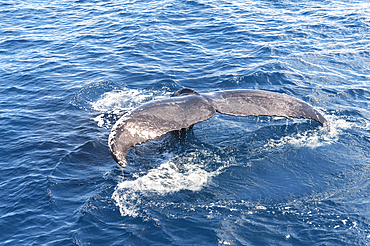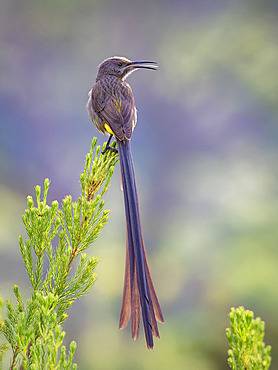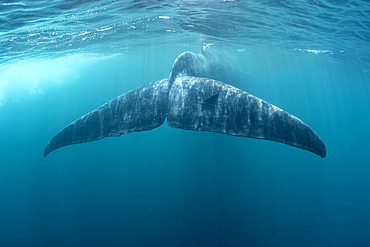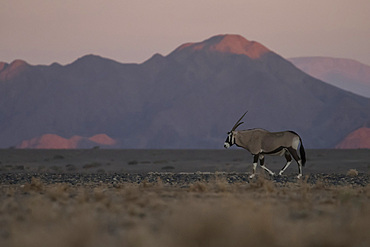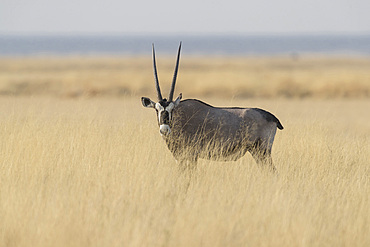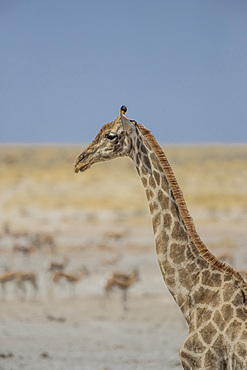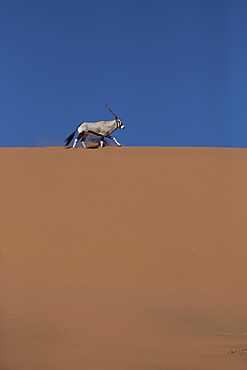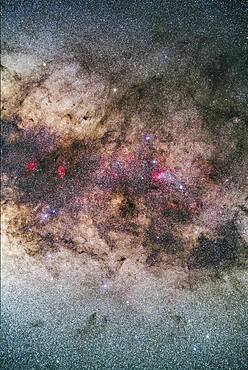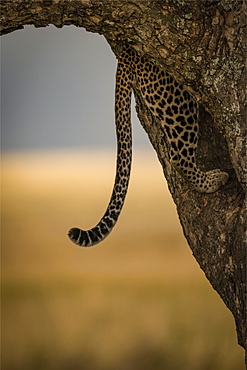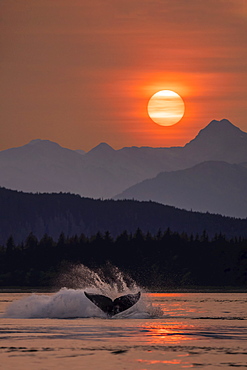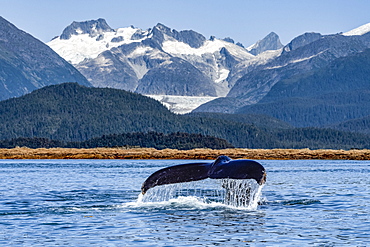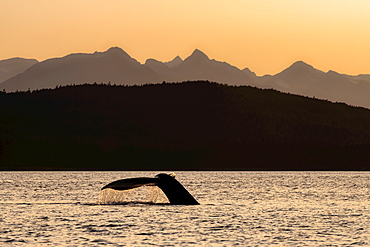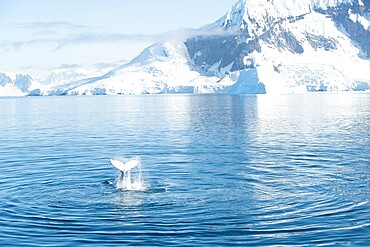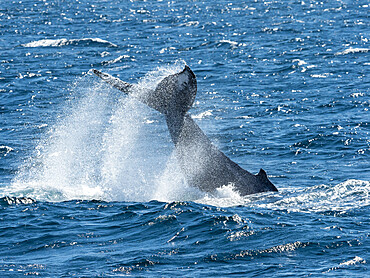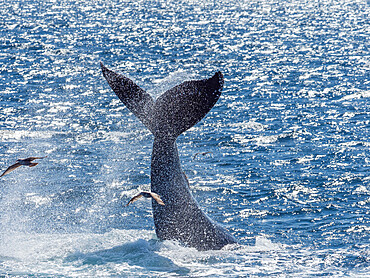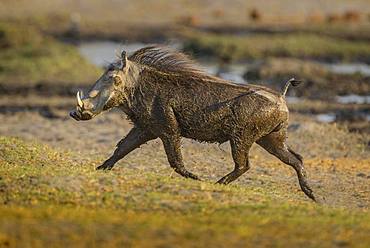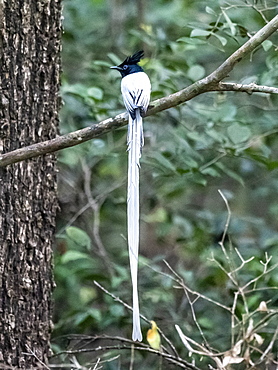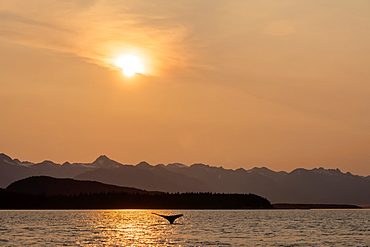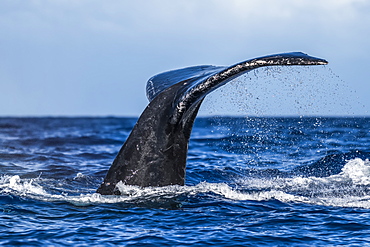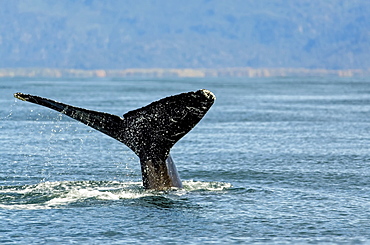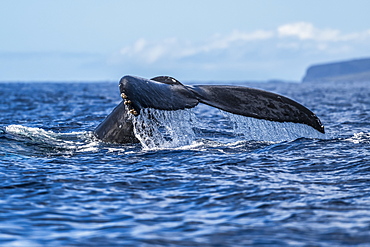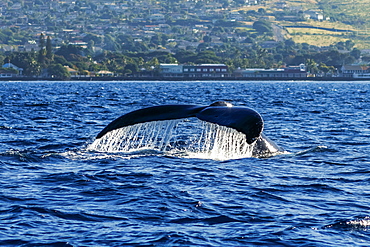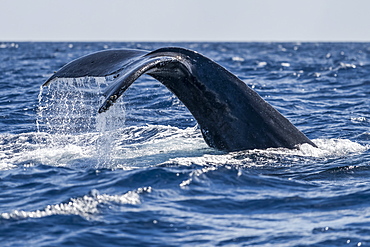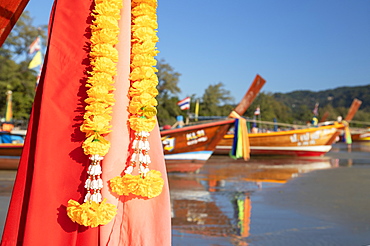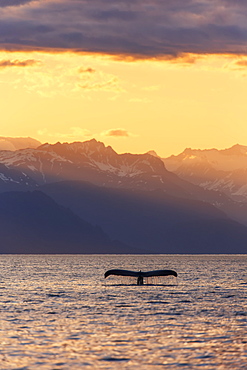Recent searches
Loading...
1116-51900 - Three African bush elephants (Loxodonta africana) cross rocky pan, Etosha National Park; Otavi, Oshikoto, Namibia
1116-51938 - Portrait of a male, common ostrich (Struthio camelus) lowering head and walking through the long grass at the Gabus Game Ranch; Otavi, Otjozondjupa, Namibia
1116-51223 - Male Pyrrhuloxia (Cardinalis sinuatus) perched on a dead branch in the foothills of the Chiricahua Mountains near Portal; Arizona, United States of America
1116-51256 - Tuna Head, Tokyo Fish Market, Tokyo, Japan
1116-51802 - Sulawesi bear cuscus or Sulawesi bear phalanger (Ailurops ursinus), Tangkoko Batuangus Nature Reserve; North Sulawesi, Indonesia
1174-10714 - The tail of a flap-necked chameleon, Chamaeleo dilepis
1113-106294 - Colourful plate with lobster tail and shrimps in an outdoor restaurant on Cayo Blanco, Cuba
1113-106715 - Tail fluke of humpback whale (Megaptera novaeangliae), Hervey Bay, Queensland, Australia
832-393579 - Indian peafowl (Pavo cristatus) spread one's tail (feathers), Bavaria, Germany, Europe
832-393578 - Indian peafowl (Pavo cristatus) spread one's tail (feathers), Bavaria, Germany, Europe
860-289661 - Cape Sugarbird (Promerops cafer), calling in territorial display, Western Cape, South Africa, July
860-289980 - Tail of Blue whale (Balaenoptera musculus brevicauda) is the largest animal ever known to have existed. This may be the pygmy sub-species of blue whale, Balaenoptera musculus. Mirissa, Sri Lanka, Indian Ocean Photo taken under permit
860-289660 - Cape Sugarbird (Promerops cafer), waving tail in territorial display, Western Cape, South Africa, July
860-289990 - Red fox (Vulpes vulpes) hunting rodents in a meadow, April, Hesse, Germany
1350-2478 - Large group of pink whipray or Tahitian stingray, Himantura fai, Rongelap, Marshall Islands, Micronesia
1350-3382 - An oryx ( Oryx gazella) at sunset in the Namib desert, Namibia
1350-3429 - Turkey tail mushroom (Trametes versicolor). Otsaportillo route. Urbasa-Andia Natural Park. Navarre, Spain, Europe
1350-3397 - Giraffe (Giraffa camelopardalis) with impalas in the background, Etosha National Park, Namibia
1350-3392 - An oryx ( Oryx gazella) in the Namib desert, Namibia
1174-10547 - The tail of a leopard on the ground, Panthera pardus, Londolozi Game Reserve, South Africa
846-3063 - Bantham Sand beach and Long Stone from Bigbury-on-Sea with Bolt Tail in distance, Bigbury-on-Sea, South Hams, Devon, England, United Kingdom, Europe
1350-91 - A telescopic closeup of Comet Lovejoy (C/2014 Q2) on January 19, 2015. I shot this from near Silver City, New Mexico, using a TMB 92mm apo refractor at f/4.4 and using a Canon 6D at ISO 1600 for a stack of 4 x 5 minute exposures. The ion tail is primarily from a single exposure to minimize blurring from the comet's motion relative to the stars. The rest of the image is from the stacked combination to minimize noise.
1350-93 - A telescopic closeup of Comet Lovejoy (C/2014 Q2) on January 17, 2015, showing structure in the ion gas tail, in the form of streamers and discontinuities in the tail.
1350-116 - This is Comet NEOWISE (C/2020 F3) over the Horseshoe Canyon formation near Drumheller, Alberta on the night iof July 10-11, 2020, taken about 2 a.m. MDT with the comet just past lower culmination with it circumpolar at this time. Warm light from the rising waning gibbous Moon provides the illumination. The comet's faint blue ion tail is just barely visible even in the moonlit sky and low altitude. The glow of summer perpetual twilight at latitude 51.5�8 N still colours the northern horizon despite this being close to the middle of the night.
1350-120 - This is Comet NEOWISE (C/2020 F3) over Deadhorse Lake near Hussar in southern Alberta, taken just after midnight on July 10-11, 2020 during its evening appearance. The comet shines just above low noctilucent clouds. The slight wind ruffled the waters enough to prevent the clean reflection I was after.
1350-685 - Peacock tail feathers are pigmented brown, but their microscopic structure makes them also reflect blue, turquoise, and green light, and they are often iridescent.
1350-134 - The tail of Scorpius, photographed with it high in the sky from Australia. The frame is oriented with the Milky Way running horizontally and the hook of the tail vertically.
1350-34 - All of Scorpius, plus parts of Lupus and Ara regions of the southern Milky Way. This area was directly overhead when I took this at about 4:30 am local time on April 6, 2014 from near Coonabarabran, Australia. The head of Scorpius is at top his tail at bottom though you could turn this image any direction and it would be correct as seen in the sky at this latitude, depending on the time of night. But in portrait mode like this north is at top. Along the Milky Way are numerous nebulas, including the False Comet area, the Cat's Paw area, and the colourful nebulas around Antares at top. The dark Pipe Nebula is at left of frame.
1350-16 - Comet Holmes, 17P, taken Nov 1, 2007 on excellent night. Taken with A&M 105mm apo refractor at f/5 with Borg 0.85x compressor/field flattener on SkyWatcher HEQ5 mount. Canon 20Da camera at ISO400. Composite of 4 min, 2min, 1min, 30sec, 15sec, and 7 sec exposures, each exposure being a stack of 3 to 4 identical exposures. Registered and stacked in Photoshop (HDR mode did not produce usable result, so manually composited with sucessively smaller masks to reveal short exposure content around nucleus. Contrast exaggerated with Curves to bring out very faint tail structure. North up, so tail to the S and SW.Nucleus is dot at upper left of inner coma, other star in inner coma at right is a field star
1348-2149 - Bacterium responsible for syphilis. Electron micrograph of Treponema pallidum on cultures of cotton-tail rabbit epithelium cells (Sf1Ep).Treponema pallidum is the causative agent of syphilis. In the United States, over 35,600 cases of syphilis were repor
1348-1152 - Syphilis bacterium. Treponema pallidum subsp pallidum on cultures of cotton tail rabbit epithelium cells Sf1Ep
1116-49275 - Tail of leopard (Panthera pardus) hangs down while climbing tree, Serengeti, Tanzania
1116-49961 - Humpback whales (Megaptera novaeangliae) surfacing in Inside Passage in the Lynn Canal under the glow of the setting sun; Alaska, United States of America
1116-49969 - Humpback whale (Megaptera novaeangliae) lifts it's fluke as it feeds in Lynn Canal, with Herbert Glacier and Coast Range in the background; Alaska, United States of America
1116-49968 - Silhouetted Humpback whale (Megaptera novaeangliae) lifts it's fluke as it feeds at sunset in Lynn Canal along the Alaska coastline; Alaska, United States of America
1335-87 - Humpback whale slapping tail with Antarctic background, Antarctica, Polar Regions
1112-5626 - Adult humpback whale (Megaptera novaeangliae), tail-lobbing, Gorda Banks, Baja California Sur, Mexico, North America
1112-5627 - Adult humpback whale (Megaptera novaeangliae), tail-lobbing, Gorda Banks, Baja California Sur, Mexico, North America
832-389407 - Detail of tail fin, parrot fish (Scarus), Pacific, Great Barrier Reef, UNESCO World Heritage, Australia, Oceania
812-177 - Long-tail boat taxis, Bangkok, Thailand, Southeast Asia, Asia
1174-9186 - High angle view of rear end of a red coated young Cavapoo lying on a lawn, Watlington, Oxfordshire, United Kingdom
832-388463 - Hoopoe (Upupa epops) Old bird feeds the young bird with lizard tail, Middle Elbe Biosphere Reserve, Saxony-Anhalt, Germany, Europe
832-388235 - Aircraft tail units of several Airbus A380 of the airline Emirates, aircraft lined up at the terminal, Dubai Airport, Dubai, United Arab Emirates, Asia
832-388461 - Hoopoe (Upupa epops) with lizard tail as food, during foraging, Biosphere Reserve Mittelelbe, Saxony-Anhalt, Germany, Europe
149-3173 - Long tail boats, Railay Beach, Krabi, Thailand, Southeast Asia, Asia
149-3101 - Long tail boats, Railay Beach, Krabi, Thailand, Southeast Asia, Asia
1174-8233 - Rear view of brown Comtois horse with silver tail in a forest, Devon, United Kingdom
832-384449 - Lyre-tail hogfish (Bodianus anthioides) swims over coral reef, Red Sea, Egypt, Africa
832-386417 - Warthog (Phacochoerus aethiopicus) after a mud bath, running with tail raised, Moremi Wildlife Reserve, Ngamiland, Botswana, Africa
1112-4916 - Humpback whale (Megaptera novaeangliae), tail lobbing in Monterey Bay National Marine Sanctuary, California, United States of America, North America
1112-4892 - Adult Indian paradise flycatcher (Terpsiphone paradisi) perched on a tree in Wilpattu National Park, Sri Lanka, Asia
1112-4891 - Adult Indian paradise flycatcher (Terpsiphone paradisi), perched on a tree in Wilpattu National Park, Sri Lanka, Asia
1116-47507 - Plains zebra (Equus quagga) stands in grass watching camera, Serengeti National Park, Tanzania
1116-47675 - Humpback whale (Megaptera novaeangliae) swimming at dusk in the Inside Passage of Lynn Canal with the Chilkat Mountains in the background, Alaska, United States of America
1116-47625 - Humpback whale (Megaptera novaeangliae) fluke, Lahaina, Maui, Hawaii, United States of America
1116-49023 - Red Squirrel (Sciurus vulgaris) eating from it's hand while standing on a moss covered rock, Dumfries and Galloway, Scotland
1116-47264 - Leopard (Panthera pardus) crouching in tree in the Ndutu area of the Ngorongoro Crater Conservation Area on the Serengeti Plains, Tanzania
1116-48438 - Humpback whale (Megaptera novaeangliae) fluke along the coast of Kachemak Bay, Homer, Alaska, United States of America
1116-47939 - Close-up of plains zebra (Equus quagga) turning head around to look at camera, Maasai Mara National Reserve, Kenya
1116-47905 - Close-up of tail of cheetah (Acinonyx jubatus) in grass, Maasai Mara National Reserve, Kenya
1116-47616 - Humpback whale (Megaptera novaeangliae) fluke, Lahaina, Maui, Hawaii, United States of America
1116-48406 - Humpback whale (Megaptera novaeangliae) tail fluke, Lahaina, Maui, Hawaii, United States of America
1116-48917 - Car tail lights illuminate the blowing snow on the Seward Highway during a dark, winter night, Turnagain Arm, Kenai Peninsula, South-central Alaska, Alaska, United States of America
1116-48439 - Humpback whale (Megaptera novaeangliae) fluke along the coast of Kachemak Bay, Homer, Alaska, United States of America
1116-48329 - Humpback whale (Megaptera novaeangliae) fluke seen while the whale is diving, Hartley Bay, British Columbia, Canada
1116-47259 - Sykes (or White-throated monkey) Monkey (Cercopithecus albogularis) hangs from branch by one foot to drink from pond at Ngare Sero Mountain Lodge, near Arusha, Tanzania
1116-47622 - Humpback whale (Megaptera novaeangliae) fluke, Lahaina, Maui, Hawaii, United States of America
1116-47621 - Humpback whale (Megaptera novaeangliae) fluke, Lahaina, Maui, Hawaii, United States of America
1116-48537 - Humpback whale (Megaptera novaeangliae) fluke, Lahaina, Maui, Hawaii, United States of America
1116-47626 - Humpback whale (Megaptera novaeangliae) fluke, Lahaina, Maui, Hawaii, United States of America
1174-7978 - A mother leopard, Panthera pardus, and its cub stand behind a log, tail up, direct gaze, Londolozi Game Reserve, Greater Kruger National Park, South Africa
800-3952 - Long tail boats on Kata Beach, Phuket, Thailand, Southeast Asia, Asia
800-3949 - Long tail boats on Kata Beach, Phuket, Thailand, Southeast Asia, Asia
799-3975 - Bolt Tail from the dramatic ledges along the South Hams coast in winter, Thurlestone, Devon, England, United Kingdom, Europe
1276-2162 - Maya Bay with long-tail boats, Phi Phi Lay Island, Krabi Province, Thailand, Southeast Asia, Asia
1276-2163 - Maya Bay with long-tail boats, Phi Phi Lay Island, Krabi Province, Thailand, Southeast Asia, Asia
1276-2160 - Amazing Blue Water at Bamboo Beach, Maya Bay with long tail boats, Phi Phi Lay Island, Krabi Province, Thailand, Southeast Asia, Asia
1276-2164 - Maya Bay The Beach with long-tail boats and tourists, Phi Phi Lay Island, Krabi Province, Thailand, Southeast Asia, Asia
1276-2161 - Maya Bay with long-tail boats, Phi Phi Lay Island, Krabi Province, Thailand, Southeast Asia, Asia
1276-2159 - Amazing Blue Water at Bamboo Beach, Maya Bay with long tail boats, Phi Phi Lay Island, Krabi Province, Thailand, Southeast Asia, Asia
1116-47195 - Fluke Of A Humpback Whale (Megaptera Novaeangliae) At Sunset, Lynn Canal, With The Chilkat Mountains In The Background, Near Juneau, Alaska, United States Of America
1116-47177 - Male Ruffed Grouse (Bonasa Umbellus) With Tail Feathers And Neck Ruff Extended In Courtship Display, Late Winter, Fairbanks, Alaska, United States Of America
1276-2139 - Long tail boats on Railay beach in Railay, Ao Nang, Krabi Province, Thailand, Southeast Asia, Asia
1276-2140 - Long tail boats on Railay beach in Railay, Ao Nang, Krabi Province, Thailand, Southeast Asia, Asia
1276-2138 - Long tail boats on Railay beach in Railay, Ao Nang, Krabi Province, Thailand, Southeast Asia, Asia
1116-46761 - Tail Of A Humpback Whale (Megaptera Novaeangliae) Out Of The Water, Hawaii, United States Of America
1116-46425 - Tail And Rear Of A Wild Horse, Theodore Roosevelt National Park, North Dakota, United States Of America
1116-46361 - Close Up Of Shrimp Filled Dumplings, Seoul, South Korea
1116-46638 - Taxis And Traffic On Shaftsbury Avenue, London, England
1116-46745 - A Whale's Tail Splashing Above The Surface Of The Water And The Coastline Of A Hawaiian Island In The Background, Hawaii, United States Of America
1116-46285 - Long Exposure Of Evening Traffic On The Glenn Highway Near Eagle River, Alaska, United States Of America
1116-46196 - Night Image Of Seattle Cityscape And I-5 On A Cloudy Night, Seattle, Washington, United States Of America
1112-4391 - Adult humpback whale (Megaptera novaeangliae), tail-lobbing at Los Cabos, Baja California Sur, Mexico, North America
1112-4384 - Short-finned pilot whale (Globicephala macrorhynchus), tail-lobbing off Isla San Marcos, Baja California Sur, Mexico, North America








